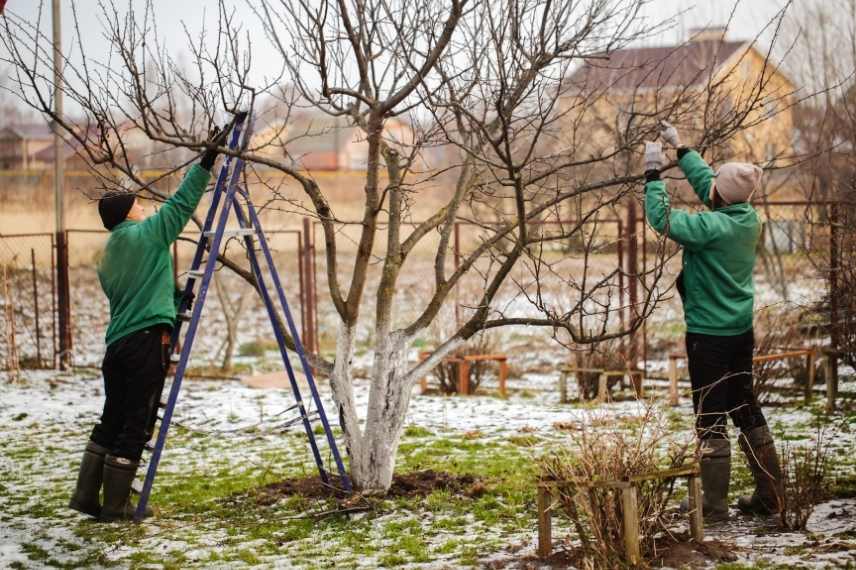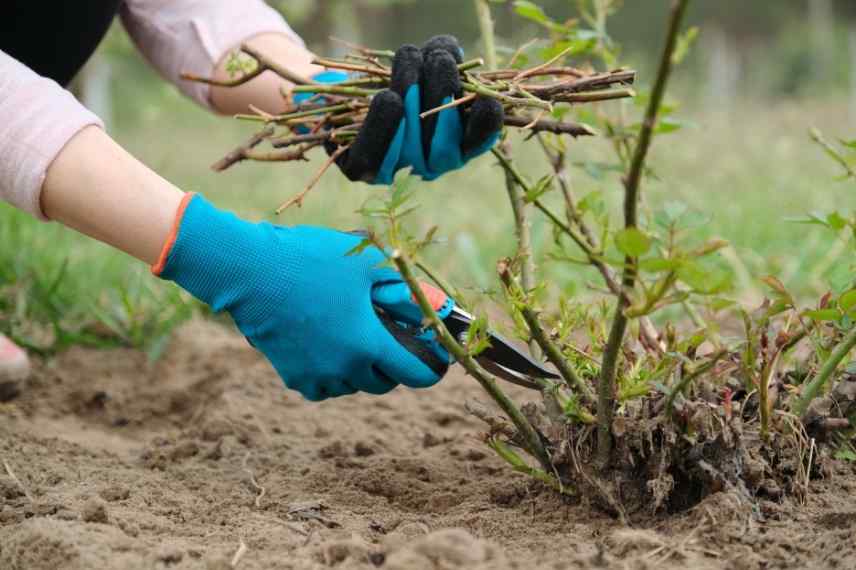
What to prune in winter?
Pruning tasks to be carried out from December to March
Contents
Winter is not just a dead season in the garden. In any case, for the gardener, during this period of vegetative rest for trees and bushes when sap is not yet circulating in the cells, pruning is the right time for a number of plants. This winter pruning will allow for good branching and development of young bushes, or improve their shape; it also encourages flowering and even fruiting… In short, pruning or performing cuts in winter is sometimes necessary. However, the timing of pruning depends on the flowering period of the bushes, to avoid compromising their future blooms, and its timing varies according to regions and the severity of winter. Pruning can be either severe or gentle depending on the type of bush. Finally, note that apart from fruit trees and large trees, it is often at the end of winter (February to mid-March) that you will intervene.
To help you keep track, here is a brief summary of the pruning tasks to be carried out in winter, a crucial period in the garden, always outside of frost periods.
Trees
In a dormant state, trees are ready for radical pruning, namely pruning. This type of pruning, which is always traumatic, is less so in mid-winter when the sap is no longer flowing. Between the time the leaves have fallen (generally late November) and the new shoots appearing in March, it is time to act to:
- Prune dead branches: winter winds often take a toll on old trees or those with fragile branches, as you may notice during storms. It is important to cleanly cut broken or torn branches and dead wood.
- Prune: for large specimens and mature trees, it is advisable to call in a professional who performs gentle, non-traumatic pruning for the tree. This includes branches that cross and grow inward towards the canopy, but you may also consider shortening some branches that have become too long. Oaks, willows, and linden trees respond better than other species. Operate in January, February, and up to March.
- Trees susceptible to gummosis such as birch and walnut, as well as stone fruit trees. This resinous substance flows from the trunks and branches and can have several causes. If you observe an atrophied or torn branch, cut it cleanly.

In a dormant state, it is the time for pruning trees
Fruit trees
The ideal pruning period for fruit trees extends from January to mid-March, before the sap rises. At this time, the aim is to allow more light into the tree (the summer pruning in June will affect fruiting).
-
Pruning pip fruit trees
This concerns apple trees, pear trees, quince trees, in free-standing or trained forms (from mid-December to March), otherwise the trained forms may grow in all directions and produce less fruit. Prune the wood shoots and other regrowth. This pruning aims to aerate the branches to allow sufficient sunlight into the tree. Feel free to consult our product sheets, which all contain a section on maintenance and pruning.
Learn more in our sheets on Fruit trees, the formative pruning of a young shoot, pruning low-stem fruit trees, and standard trees, Pruning fruit trees in palmate form
 Winter pruning of the apple tree
Winter pruning of the apple tree
-
Pruning hardy fruit trees or bushes
This includes hazel, persimmon, medlar, walnut: just after flowering for the medlar, in December, and during January-February for the others to remove dead wood and crossing branches of small diameter. The hazel benefits from rejuvenation to stimulate new shoots and remove aging branches. Learn more in our advice sheet Pruning hazel, when and how? and in our video: How to prune a hazel?
-
Rejuvenation or restoration pruning of the fig tree
In January or February, every 10 years on the oldest branches. The fig tree regenerates well on old wood; otherwise, a light pruning in March to renew the shoots (the fig tree produces on one-year-old shoots) is recommended to maintain a reasonable volume of the tree and ensure good fruit production.
-
Pruning the vine and kiwis occurs from February to mid-March
Discover our pruning tips in Stéphanie’s tutorial When and how to prune kiwi? and Olivier’s video on pruning the vine
-
Pruning the olive tree
To achieve a good harvest, thinning pruning should be done in March. Also prune the suckers formed at the base. Learn more in our advice sheet: Olive tree pruning, everything you need to know
 Pruning of the vine and olive tree
Pruning of the vine and olive tree
-
Pruning small fruits
Currant bushes or gooseberries and blackcurrants, everbearing raspberries, cultivated blackberries: proceed between mid-January and the end of February, tip the stems that have fruited, and remove the darker, brittle canes. These branches make excellent dry kindling for the fire. Wearing gloves, bundle them into faggots to use as fire starters.
Discover our pruning tips in our advice sheets: Pruning currants and blackcurrants and pruning raspberries
 Pruning of the blackcurrant
Pruning of the blackcurrant
-
Pruning citrus trees
This should be done if necessary at the end of winter, and is more essential for potted specimens. Learn more with Alexandra’s advice: Citrus trees, when and how to prune?
Roses
It is in winter that we busy ourselves with pruning roses: in February in mild regions, in March in most areas. That said, milder winters encourage us to prune earlier, often from mid-February, as vegetation begins to emerge. Dispose of your pruning waste at the tip to prevent the spread of diseases if your roses are affected.
You can prune very short, cutting back to 10 cm from the ground (for recently planted specimens or to rejuvenate older ones), or perform an intermediate pruning to half their height (suitable for well-established roses), or finally a long pruning where you only cut back a third of very vigorous roses, or those in unsuitable conditions (sandy soil, for example).
Two scenarios for winter pruning of roses:
- Repeat flowering roses: from mid-February to April (in mountainous areas and regions with harsh winters), whether climbing or bush roses.
- Climbing roses: from February to March (except in harsh climates like montane areas until April),
Learn more with Virginie’s expert advice in Pruning Roses: Techniques and Tips, and When to Prune Roses: Key Periods and Our Tips
 A bush rose pruned short in winter
A bush rose pruned short in winter
Ornamental bushes
You will mainly prune between December and March the shrubs that flower in summer or autumn. In any case, rely on the phenological indicators of your region, as spring does not arrive on the same dates from north to south of France! Winter pruning is also possible in other very specific cases:
- Summer-flowering shrubs can be pruned quite severely from late February to late March, just before the new shoots emerge, to ensure a magnificent flowering. Prune back at least by half the oldest stems: Buddleias, Lavateras, spiraeas, Altheas or Hibiscus syriacus, Lagerstroemias… This will allow the flowers to be more at eye level for the taller shrubs. Prune the buddleias severely if they have become unruly or too old. You may also prune your tree peonies. The Hydrangeas paniculata require pruning to about 15 cm from the ground, or at least one third of their length. Overall, drastic pruning of summer-flowering shrubs will not compromise summer flowering, but it will be later.
 Caryopteris flowering in late summer, as well as Lagerstroemia or crape myrtle, Buddleias, Lavateras… all deserve a good refresh at the end of winter to bloom abundantly
Caryopteris flowering in late summer, as well as Lagerstroemia or crape myrtle, Buddleias, Lavateras… all deserve a good refresh at the end of winter to bloom abundantly
- Some summer-flowering shrubs or undershrubs require severe pruning, even a total cut back to the stump in February-March to maintain a nice shape and ensure beautiful flowering over the years. Operate before the leaves start to emerge. This includes Perovskia and Caryopteris.
- Pruning of dead or damaged branches: as with trees, identify those that have broken due to the wind: cut below, about 1 cm from an already formed bud.
- Maintenance pruning: to balance the branches if necessary, by removing poorly oriented branches, those that are crossing or interfering, to aerate the shrub a little: Camellias after their flowering, for example.
- Shaping pruning: on young shrubs about 5 years after planting to refine their habit by raising the branches and balancing them; also cut back deciduous hedges to rejuvenate them.
- Pruning to encourage the development of coloured shoots: decorative wood dogwoods (they will produce new, well-coloured wood next winter), goat willows (Salix caprea), all should be pruned very short in March. The Salix integra ‘Hakuro Nishiki’ or shrimp willow is also pruned in February-March, to maintain its beautiful and typical spring coloration on young shoots.
→ Learn more about pruning dogwoods in Olivier’s video Pruning decorative wood dogwoods
 Pruning decorative wood dogwoods
Pruning decorative wood dogwoods
- For evergreen shrubs (conifers, Photinia, Laurustinus, mahonias, holly, St. John’s wort, but also Helichrysum for example)… wait until the end of winter, they will be less weakened by pruning in mid-March or April.
Climbing
Some climbing plants need to be pruned in winter to produce a wealth of flowers in summer. Winter pruning also helps to address the bare base issue.
- Group 3 clematis, which are very floriferous, often with large flowers blooming in summer or late flowering until October: they grow on this year’s shoots, such as the Clematis viticella, Clematis orientalis, Clematis tangutica, Clematis texensis, and some hybrids that flower at the end of summer. The later the flowering, the more you can prune severely. Generally, you should prune to 30-40 cm above the soil in February or March. These stunning clematis will have plenty of time to produce new vigorous shoots. Learn more in our advice sheet: How to prune and maintain clematis
- Deciduous woody climbers: Trumpet vine and Wisteria from mid-February (March in colder regions to avoid damaging tender shoots with frost). As with roses, remove vertical shoots and retain the horizontal framework, which is more floriferous.
Learn more about pruning trumpet vine in our sheet Pruning trumpet vine and about pruning Wisteria with Alexandra’s tips: Wisteria, how to train and prune it?
Perennials and grasses
Let’s not forget the perennials that really need a bit of tidying up at the end of winter, often as early as mid-February, to achieve a more polished appearance (the dry stems left in place have served their protective role at the level of the stumps, which is why they are left; they also provide a refugium for wildlife). This allows space for the new spring shoots that emerge from the soil. Carry out this task later rather than too early, even if the desire for more aesthetically pleasing borders is tempting you.
You can easily remove the withered foliage that comes away on its own or neatly cut back the stems and leaves that resist with pruning shears. Cut them and then spread them as mulch around and within your borders. This applies to:
- Herbaceous perennials: Peonies, Brunneras, Gaura, Verbena from Buenos Aires, Phlomis, Echinaceas, hardy geraniums, Eryngiums…
- Deciduous grasses: cut them back to about 10 cm from the ground (Calamagrostis, Molinies, Miscanthus, and your grasses that are starting to green) to rejuvenate them. Learn more in our video how to prune grasses
- Aromatic plants like savory or thyme: a short pruning prevents them from becoming too woody
The only exception is herbaceous salvias, which should be pruned to 15-20 cm from the ground at the very end of winter, late March, almost to the ground for herbaceous salvias, and halfway for shrubby salvias.
- Subscribe!
- Contents
































Comments